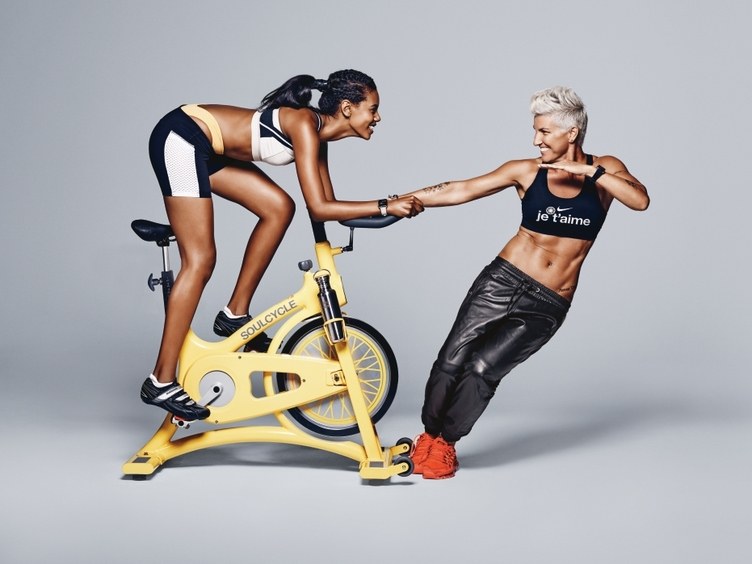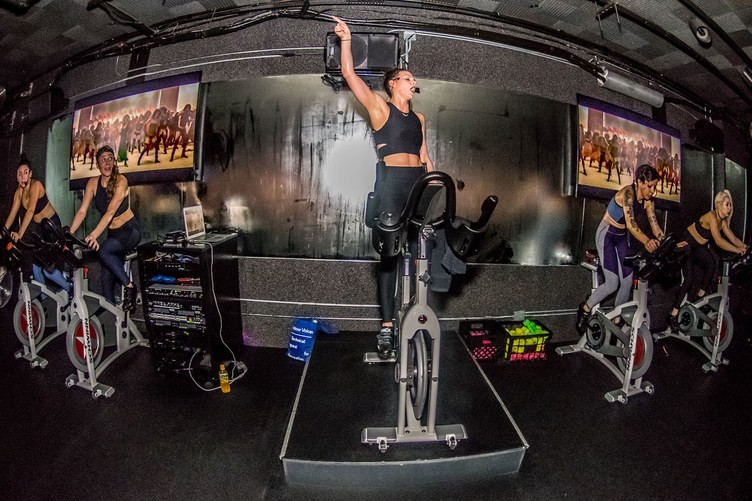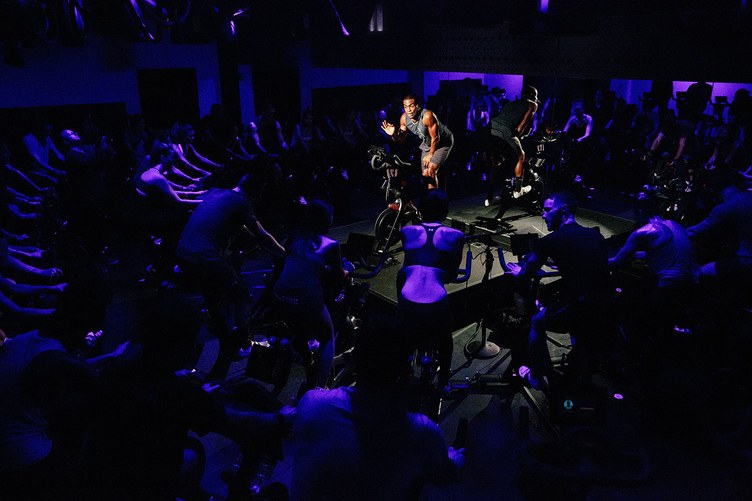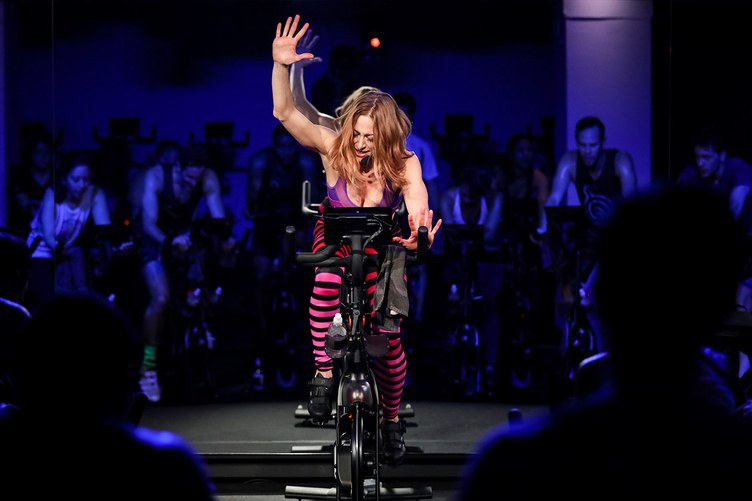
A huge part of any indoor cycling class you take is the relationship you develop with the instructor. Whether you love their music, dig their vibe, or have a serious crush on them, getting yourself to their early morning class is just a little bit easier.
Behind the scenes, hundreds of hours go into the creation of that instructor’s personal brand, and just as many hours go into the process of becoming an instructor. It’s certainly not easy to pass the tryouts, rise through the ranks, and earn a place for yourself on the schedule.
The process is slightly different everywhere, so we reached out to many of the popular boutique indoor cycling studios across the country for a glimpse.
Some studios consider their instructor hiring and training process a trade secret. For example, “all SoulCycle instructors go through an immersive 10-week training program (the specifics of which we do not divulge),” the team at SoulCycle tells SELF.
Here’s what we did find out.

Instructors come from a variety of backgrounds. Sometimes they’re picked out of the crowd.
You might go to class often, sit in the front row, and just have an aura about you that makes the instructors take notice. Selina Santos, an instructor at JoyRide in Connecticut, went to classes five times a week, and “eventually the owner plucked me out of the pit and said you need to teach.”
Other instructors start with a group fitness or personal training certification from a respected organization, such as the American Council on Exercise, the National Strength and Conditioning Association, or the National Academy of Sports Medicine. Some have dance backgrounds and love teaching group dance or fitness classes. They may find a natural fit with indoor cycling and its combination of music, inspiration, and choreography.
Make sure you love the studio, because you’ll spend a ton of hours there for training.
Every studio is different, and it’s important to match the type of riding you do with the studio’s style. If you love riding a bike but aren’t interested in incorporating abs work, dance moves, and push-ups as you ride, for example, a studio like SoulCycle probably isn’t going to be right for you.
“I don’t do a lot of things like push-ups on the handlebars, no dumbbells. I’m on a bike to ride and to build endurance and fitness, so my class is more of an interval-based conditioning class,” Andrew Kalley, a CPT and USA Triathlon level 2 coach at Chelsea Piers, tells SELF.

Each studio has its own tryout process. You might get through in one round, two, or three—or not at all.
You’ll likely have to try out just to get into a training program. Depending on the studio, you could do one tryout or multiple tryouts. Once accepted, you’ll start learning a lot of basics and taking a ton of classes. “[My training involved] learning the metrics of the bike, the number pairings, resistance, and cadence,” Jess King, instructor at Peloton, tells SELF. She also learned how to map out a ride and practical tips like how to ride and speak at the same time.
You might also go through multiple auditions throughout the process—first to get into training, then midway through training, and then at the end. “Halfway through we have a midway audition to see is [the training] sinking in and is it taking? I don’t want to waste anyone’s time, so if they’re like ‘This isn’t for me, I just don’t want to put the time in,’” Dyan Tsiumis, head instructor at SWERVE, tells SELF.
Training can last several months.
The training process can take a while. “Some people you’ll talk to, it can be a four-week training program. I’ve run some and they last several months,” Kristin Kenney, instructor at FlyWheel, tells SELF. Each boutique studio has its own training regimen and time line.
About 75 percent of training is on the bike, Tsiumis says. You’re not just there during training; you’re also taking other instructors’ classes to learn from them and to increase your endurance. Each studio has its own preferences and policies, so you’ll learn all about the bikes proprietary to them, plus exactly how they want you to structure a class, what to look for in terms of creating a playlist, and of course, proper form on the bike.

Once training is finished, you have to earn your spot on the schedule, and it can take a while.
You’ve finally finished training, so it’s time to start teaching classes, right? Not yet. You might go through a few more tryouts, then lead community classes or private rides. During community rides, you’re in charge of inviting your friends and filling the studio. It’s a good way to get feedback on your classes before you land on the official schedule.
The studio that trained you may or may not hire you right away, or they may just need a few extra backup teachers. At some spots you might make it through training only to learn the studio might not need an instructor with your riding style, or they might need you in another location, or it might not work at all. “You’ll know that really fast,” Kenney says.
However, starting as a sub isn’t the worst thing. You’re thrown into many class times and locations, so you can learn what you love and what you don’t. “I was teaching one to three classes a week for three months. It was hard to get a groove and figure out what your style is, but then with summer subs, especially in the Hamptons, I became a chameleon,” Bree Branker, Spin instructor at Imax Shift, tells SELF. No matter how long it takes for you to find your groove, the more time you put in, the more experience you’re getting.
“As a new instructor, you have to work your way to the top like anything else!” Holly Rilinger, creative director at Cyc, tells SELF. “I taught the 7 A.M. on weekends in the Hamptons, traveling two and a half to three hours each way. Usually to three to four people! I remember giving bikes away to try to build a following.” Her wait list now numbers more than 100.
You can have a full-time job and teach indoor cycling, but it’s not easy.
Santos is a television producer on the side, so she teaches in the morning, then goes right to work and crushes her day. When Liz Van Voorhis, master instructor at Monster Cycle, started there, she was traveling every two weeks for a while before deciding to make the studio her full-time gig.
Other studios let you practice on their bikes only during off-peak times, so it’s pretty tricky to have a full-time gig and train. Certain studios will tell you it’s your full-time job to be there while you’re training, so be sure to figure out in advance if you want to have a paycheck coming in another way

Many part-time group cycling instructors have a side hustle.
It’s not unusual for instructors to also have another type of job. For some, that’s personal training. (King runs a transformation business; Branker teaches with Akin’s Army; Kalley is a triathlon coach.)
Oftentimes, working as an indoor cycling instructor helps you connect with others in a new way, and it makes sense for instructors to take advantage of their growing fan base. “Peloton has provided us with a platform, and if I have the drive to connect and share more of what we’re passionate about, I can. They support our [personal] brands. The bigger our personal brands, the stronger we are there,” King says.
Indoor cycling can open up new opportunities you didn’t expect. For Branker, many new chances arose once she started teaching full time, from fitness modeling to Instagram requests. Brands want experts to test their gear and potentially become ambassadors, so they tend to reach out to people who live and breathe fitness all day long.
The process is tough, but everyone we talked to would go through it all again, because they love where they ended up.
Everyone was brutally honest—it’s hard. “Great instructors make it look so easy and fun, [but] they put in time to make it look easy,” Tsiumis says. When she first started, it wasn’t uncommon for her to be up at 6 A.M. teaching on Wall Street and then running all town, ending up in the Bronx at 10 P.M.
If you want to break into the industry, be prepared to be vulnerable, experts say. Yes, you can learn the timing of things and how to plan out the perfect Spin class, but you also have to experience the class with the group you’re teaching. If you mess up, it happens. “You have to own the failure, but own it with a sense of humor—it makes you relatable,” King says. Failure is hard in any position, but especially when you’re in front of 20 or more indoor cyclists.
Once you’re willing to put yourself out there, Branker says, that’s when the true nature of your class and your vibe really start to shine through. In the end, “authenticity always wins,” Rilinger says.




